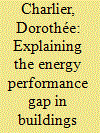| Srl | Item |
| 1 |
ID:
186462


|
|
|
|
|
| Summary/Abstract |
One of the main strategies employed to increase the energy efficiency of buildings is the insulation and sealing of building envelopes. This has led to considerable reductions in energy consumption in recent decades. However, with the increasing efficiency of the building envelope, a contrary effect is also evident: energy performance gaps (EPGs), the phenomenon where actual consumption exceeds calculated demand. While EPGs have often been associated with rebound effects, socio-technical studies argue that it is the interactions between occupants and buildings (or building technologies), which have negative, often unintended, consequences for energy consumption. To analyse these interactions and their contribution to EPGs, we conducted a survey of 34 households in two moderately insulated multi-apartment buildings and calculated EPGs at the apartment level. Based on the results, we argue that increasing the building insulation can lead to negative interaction effects because occupants adapt to the changes in building behaviour, producing a shift in energy consumption for the whole building. Building inertia and reduced feedback are likely accompanied by higher indoor temperatures and increased ventilation. We suggest that a better understanding of these mechanisms is necessary to evaluate the real savings of different efficiency measures, and discuss various implications for policy and research.
|
|
|
|
|
|
|
|
|
|
|
|
|
|
|
|
| 2 |
ID:
179716


|
|
|
|
|
| Summary/Abstract |
The aim of this research is to identify energy consumption profiles that explain the difference between actual and theoretical energy consumption (the energy performance gap) in the residential sector using latent profile analysis (LPA). The resulting profiles inform behavioral and socio-demographic differences in consumption patterns among households and help explain inconsistencies in prior research on the energy performance gap. This research demonstrates that under-consumption of energy compared with the theoretical measure is partially explained by behavior related to poverty and deprivation. To address this, preventive measures should be put in place that focus on renovation or social housing to enable the poorest households to heat their dwellings adequately. Particular attention could also be paid to households that consume the most to avoid bias in energy forecasting models.
|
|
|
|
|
|
|
|
|
|
|
|
|
|
|
|
| 3 |
ID:
171360


|
|
|
|
|
| Summary/Abstract |
This paper addresses the thermal Energy Performance Gap (EPG), defined as the difference between a building's theoretical and actual energy consumption for thermal purposes (heating and hot water). Successful energy policies require estimates of the energy saving potential of the building stock. It is the objective of this work to analyse whether and to what extent an EPG exists in residential buildings in Switzerland. The database of the Swiss Cantonal Energy Certificate for Buildings was used, covering over 50 000 buildings.
The median EPG was found to be −11% (i.e. actual consumption lower than theoretical) but varied across ratings from 12.4% (B-label) to −40.4% (G-label). Buildings with low energy ratings tend to consume significantly less than expected, while buildings with high rating tend to consume slightly more than expected. For the A-labels buildings (0.5% of the total) an EPG of −6.2% was found, suggesting that the very high-performance buildings may be more robust to the EPG.
Simplified scenarios to illustrate the impact of this EPG on total consumption are presented, which highlight the challenge of meeting the Swiss Energy Strategy 2050 with a realistic renovation rate. The importance of low carbon heat supply for buildings is also discussed.
|
|
|
|
|
|
|
|
|
|
|
|
|
|
|
|